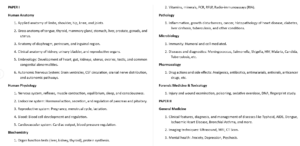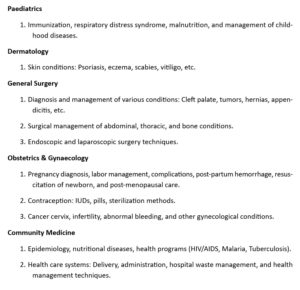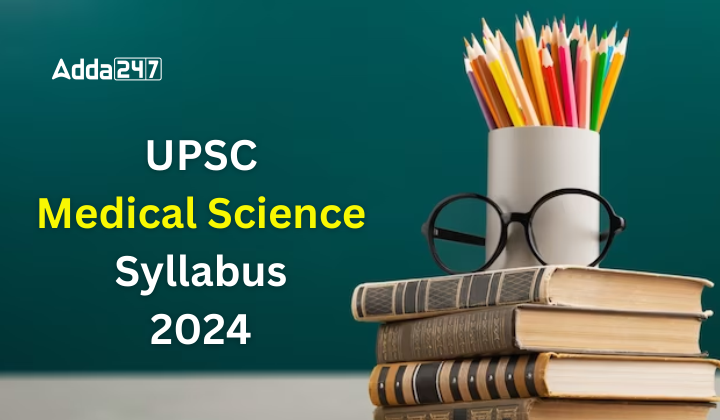Table of Contents
The UPSC optional subjects include 48 subjects, one of which is Medical Science. The Medical Science syllabus focuses on testing candidates’ understanding of basic medical concepts and their ability to apply this knowledge to patients. It covers topics like general medicine, important medical knowledge, and community medicine. This article provides the UPSC Medical Science Syllabus along with images/PDFs to help with your preparation.
UPSC Medical Science Syllabus 2025 Overview
Medical Science is a great choice for UPSC Mains candidates who have a strong background in the medical field. It is suitable for those with degrees in Medical Science or professionals like doctors, nurses, biomedical engineers, and pharmacists. The Medical Science optional consists of two papers, Paper I and Paper II, each of 250 marks, for a total of 500 marks.
UPSC Medical Science Syllabus 2025
Medical Science is a great choice for UPSC Mains candidates who have strong knowledge and passion for the medical science subject. Candidates can refer to the details of both paper in the following images


UPSC Medical Science Syllabus 2025 for Optional Paper I
Candidates can check out the Topic-wise UPSC Medical Science Syllabus for Mains Optional paper I.
1. Human Anatomy:
- Applied anatomy including blood and nerve supply of upper and lower limbs and joints of shoulder, hip, and knee.
- Gross anatomy, blood supply, and lymphatic drainage of the tongue, thyroid, mammary gland, stomach, liver, prostate, gonads, and uterus.
- Applied anatomy of the diaphragm, perineum, and inguinal region.
- Clinical anatomy of kidney, urinary bladder, uterine tubes, vas deferens.
- Embryology: Placenta and placental barrier. Development of heart, gut, kidney, uterus, ovary, testis, and their common congenital abnormalities.
- Central and peripheral autonomic nervous system: Gross and clinical anatomy of ventricles of the brain, circulation of cerebrospinal fluid; Neural pathways and lesions of cutaneous sensations, hearing and vision; Cranial nerves, distribution, and clinical significance; Components of the autonomic nervous system.
2. Human Physiology:
- Conduction and transmission of impulse, mechanism of contraction, neuromuscular transmission, reflexes, control of equilibrium, posture and muscle tone, descending pathways, functions of the cerebellum, basal ganglia, Physiology of sleep and consciousness.
- Endocrine system: Mechanism of action of hormones, formation, secretion, transport, metabolism, function, and regulation of secretion of pancreas and pituitary gland.
- Physiology of reproductive system: menstrual cycle, lactation, pregnancy.
- Blood: Development, regulation, and fate of blood cells.
- Cardio-vascular, cardiac output, blood pressure, regulation of cardiovascular functions;
3. Biochemistry:
- Organ function tests-liver, kidney, thyroid Protein synthesis.
- Vitamins and minerals.
- Restriction fragment length polymorphism (RFLP).
- Polymerase chain reaction (PCR).
- Radioimmunoassays (RIA).
4. Pathology:
- Inflammation and repair, disturbances of growth and cancer, Pathogenesis and histopathology of rheumatic and ischemic heart disease and diabetes mellitus. Differentiation between benign, malignant, primary, and metastatic malignancies, Pathogenesis and histopathology of bronchogenic carcinoma, carcinoma breast, oral cancer, cancer cervix, leukemia, Etiology, pathogenesis and histopathology of – cirrhosis liver, glomerulonephritis, tuberculosis, acute osteomyelitis.
5. Microbiology:
- Humoral and cell-mediated immunity.
- Diseases caused by and laboratory diagnosis of-
- Meningococcus, Salmonella
- Shigella, Herpes, Dengue, Polio
- HIV/AIDS, Malaria, E. Histolytica, Giardia
- Candida, Cryptococcus, Aspergillus
6. Pharmacology:
- Mechanism of action and side effects of the following drugs:
- Antipyretics and analgesics, Antibiotics,
- Antimalaria; Antikala-azar,Antidiabetics
- Antihypertensive, Antidiuretics, General and cardiac vasodilators, Antiviral, Antiparasitic, Antifungal, Immunosuppressants
- Anticancer.
7. Forensic Medicine and Toxicology:
- Forensic examination of injuries and wounds; Examination of blood and seminal stains; poisoning, sedative overdose, hanging, drowning, burns, DNA and fingerprint study.
UPSC Medical Science Syllabus 2025 for Optional Paper II
Candidates can check out the Topic-wise UPSC Medical Science Syllabus for Mains Optional paper II.
1. General Medicine
- Etiology, clinical features, diagnosis, and principles of management (including prevention) of—Typhoid, Rabies, AIDS, Dengue, Kala-azar, and Japanese Encephalitis.
- Etiology, clinical features, diagnosis, and principles of management of :
- Ischaemic heart disease, pulmonary embolism.
- Bronchial asthma.
- Pleural effusion, tuberculosis, Malabsorption syndromes; acid peptic diseases, Viral hepatitis, and cirrhosis of the liver.
- Glomerulonephritis and pyelonephritis, renal failure, nephrotic syndrome, renovascular hypertension, complications of diabetes mellitus, coagulation disorders, leukemia, Hypo and hyperthyroid, meningitis, and encephalitis.
- Imaging in medical problems, ultrasound, echo-cardiogram, CT scan, MRI. Anxiety and Depressive Psychosis and Schizophrenia and ECT.
2. Paediatrics
- Immunization, Baby friendly hospital, congenital cyanotic heart disease, respiratory distress syndrome, bronchopneumonia, kernicterus. IMNCI classification and management, PEM grading and management. ARI and Diarrhea of under five and their management.
3. Dermatology
- Psoriasis, Allergic dermatitis, scabies, eczema, vitiligo, Stevan Johnson’s syndrome, Lichen Planus.
4. General Surgery
- Clinical features, causes, diagnosis and principles of management of cleft palate, harelip.
- Laryngeal tumour, oral and esophageal tumors.
- Peripheral arterial diseases, varicose veins, coarctation of aorta.
- Tumours of Thyroid, Adrenal, Glands.
- Abscess cancer, fibroadenoma, and adenosis of the breast.
- Bleeding peptic ulcer, tuberculosis of the bowel, ulcerative colitis, cancer stomach.
- Renal mass, cancer prostatic.
- Haemothorax, stones of the Gall bladder, Kidney, Ureter, and Urinary Bladder.
- Management of surgical conditions of the Rectum, Anus, Anal canal, Gall bladder, and Bile ducts.
- Splenomegaly, cholecystitis, portal hypertension, liver abscess, peritonitis, carcinoma head of the pancreas.
- Fractures of the spine, Colles’ fracture, and bone tumors.
- Endoscopy.
- Laparoscopic Surgery.
5. Obstetrics and Gynaecology including Family
- Planning Diagnosis of pregnancy.
- Laboਹr management, complications of 3rd stage, Antepartum, and postpartum hemorrhage, resuscitation of the newborn, Management of abnormal life, and difficult labor. Management of small for-date or premature newborns.
- Diagnosis and management of anemia. Preeclampsia and Toxaemias of pregnancy, Management of Post- menopausal Syndrome.
- Intra-uterine devices, pills, tubectomy, and vasectomy. Medical termination of pregnancy including legal aspects.
- Cancer cervix.
- Leucorrhoea, pelvic pain; infertility, dysfunctional uterine bleeding (DUB), amenorrhoea, Fibroid, and prolapse of the uterus.
6. Community Medicine (Preventive and Social Medicine)
- Principles, methods approach, and measurements of Epidemiology.
- Nutrition, nutritional diseases/disorders, and Nutrition Programmes.
- Health information Collection, Analysis and Presentation
- Objectives, components, and critical analysis of National programs for control/eradication of :
- Malaria, Kala-azar, Filaria and Tuberculosis,
- HIV/AIDS, STDs, and Dengue.
- Critical appraisal of Health care delivery system.
- Health management and administration; Techniques, Tools, Programme Implementation and Evaluation.
- Objectives, Components, Goals, and Status of Reproductive and Child Health, National Rural Health Mission and Millennium Development Goals.
- Management of hospital and industrial waste.
| Relatable Articles | |
| UPSC Civil Engineering Syllabus | UPSC History Syllabus |
| UPSC Law Syllabus | UPSC Mathematics Syllabus |



 TSPSC Group 1 Question Paper 2024, Downl...
TSPSC Group 1 Question Paper 2024, Downl...
 TSPSC Group 1 Answer key 2024 Out, Downl...
TSPSC Group 1 Answer key 2024 Out, Downl...
 UPSC Prelims 2024 Question Paper, Downlo...
UPSC Prelims 2024 Question Paper, Downlo...





